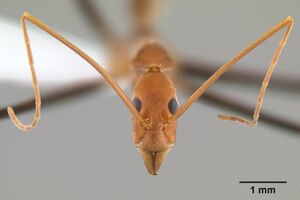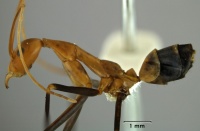Leptomyrmex darlingtoni
| Leptomyrmex darlingtoni | |
|---|---|

| |
| Leptomyrmex darlingtoni | |
| Scientific classification | |
| Kingdom: | Animalia |
| Phylum: | Arthropoda |
| Class: | Insecta |
| Order: | Hymenoptera |
| Family: | Formicidae |
| Subfamily: | Dolichoderinae |
| Tribe: | Leptomyrmecini |
| Genus: | Leptomyrmex |
| Species: | L. darlingtoni |
| Binomial name | |
| Leptomyrmex darlingtoni Wheeler, W.M., 1934 | |
| Synonyms | |
| |
Leptomyrmex darlingtoni has been recorded from rainforest, savannah, Araucaria forest and Eucalyptus woodland, in ground nests
| At a Glance | • Replete Workers |
Identification
Leptomyrmex darlingtoni is distinctive for its small size and restricted geographic range. This species can be distinguished from its only sympatric congener, Leptomyrmex rufipes, by its smaller size, HW 0.94–1.03 mm; WL 3.11–3.30 mm (L. rufipes HW 1.08–1.39 mm; WL 3.61–4.52mm), and the rounded postocular portion of the head, which lacks the neck-like constriction of L. rufipes. (Lucky and Ward 2010)
Identification Keys including this Taxon
Distribution
it is found only on Cape York Peninsula, as far south as the vicinity of Cooktown.
Latitudinal Distribution Pattern
Latitudinal Range: -10.68333333° to -33.83332825°.
| North Temperate |
North Subtropical |
Tropical | South Subtropical |
South Temperate |
- Source: AntMaps
Distribution based on Regional Taxon Lists
Australasian Region: Australia (type locality).
Distribution based on AntMaps
Distribution based on AntWeb specimens
Check data from AntWeb
Countries Occupied
| Number of countries occupied by this species based on AntWiki Regional Taxon Lists. In general, fewer countries occupied indicates a narrower range, while more countries indicates a more widespread species. |

|
Estimated Abundance
| Relative abundance based on number of AntMaps records per species (this species within the purple bar). Fewer records (to the left) indicates a less abundant/encountered species while more records (to the right) indicates more abundant/encountered species. |

|
Biology
Castes
Queens of this species have not been collected.
Worker
Images from AntWeb
     
| |
| Worker. Specimen code casent0012024. Photographer Andrea Lucky, uploaded by California Academy of Sciences. | Owned by ANIC, Canberra, Australia. |
Phylogeny
| Leptomyrmex |
| ||||||||||||||||||||||||||||||||||||||||||||||||||||||||||||||||||||||||||||||||||||||||||||||||||||||||||||||||||||||||||||||||||||||||||
Based on Barden et al., 2017. Note only selected Leptomyrmex species are included.
Nomenclature
The following information is derived from Barry Bolton's Online Catalogue of the Ants of the World.
- darlingtoni. Leptomyrmex darlingtoni Wheeler, W.M. 1934c: 104, fig. 13 (w.m.) AUSTRALIA. Senior synonym of fascigaster, jucundus: Lucky & Ward, 2010: 29.
- fascigaster. Leptomyrmex darlingtoni subsp. fascigaster Wheeler, W.M. 1934c: 107 (w.) AUSTRALIA. Junior synonym of darlingtoni: Lucky & Ward, 2010: 29.
- jucundus. Leptomyrmex darlingtoni subsp. jucundus Wheeler, W.M. 1934c: 107 (w.) AUSTRALIA. Junior synonym of darlingtoni: Lucky & Ward, 2010: 29.
Type Material
Described from numerous workers and two males taken by Dr. P. J. Darlington from a single colony at Lankelly Creek, in the McIlthwaite Range, Cape York Peninsula, Queensland. There are several fine repletes among the workers.
- Syntype, 1 worker, Coen, Cape York Peninsula, Queensland, Australia, Museum of Comparative Zoology.
- Syntype, 2 workers, Coen, Cape York Peninsula, Queensland, Australia, Museum of Comparative Zoology.
- Syntype, 5 workers, Coen, Cape York Peninsula, Queensland, Australia, Museum of Comparative Zoology.
- Syntype, 16 workers, 2 males, Lankelly Creek, McIlwraith (as McIlthwaite) Range, Cape York Peninsula, Queensland, Australia, Museum of Comparative Zoology.
- Syntype, 2 workers, Lankelly Creek, McIlwraith (as McIlthwaite) Range, Cape York Peninsula, Queensland, Australia, Museum Victoria, Melbourne.
- Syntype, 3 workers, Lankelly Creek, McIlwraith (as McIlthwaite) Range, Cape York Peninsula, Queensland, Australia, National Museum of Natural History.
Unless otherwise noted the text for the remainder of this section is reported from the publication that includes the original description.
Description
Worker
Lucky and Ward (2010) – measurements (n = 7) HL 1.60–1.72, HW 0.94–1.03, MFC 0.18–0.21, IOD 0.56–0.62, SL 3.36–3.73, EL 0.35–0.38, WL 3.11–3.30, PW 0.85–0.92, DPW 0.31–0.34, HTL 2.87–4.19, HTWmin 0.11–0.14, HTWmax 0.21–0.24, CI 0.56–0.62, SI 3.51–3.77, OI 0.09–0.11, HTC 0.50–0.61.
Small species (HW 0.94–1.03 mm; WL 3.11–3.30 mm) with head, excluding mandibles, less than twice as long as broad (CI 0.56–0.62) and widest at eye level. Sides of head straight, genae parallel and slightly concave. Behind the eyes, sides gently rounding to a flat postocular margin. Masticatory margin of mandible with approximately 15 small, irregular teeth and denticles. Anterior clypeal margin weakly concave medially. Eyes positioned posterior to midline of head, relatively large and convex, hairless, not surpassing lateral margins of head. Antennae extremely long and slender (SI 3.51–3.77), somewhat compressed, scapes surpassing posterior margin of head by 3/5 their length.
Pronotum slender, distinctly elongate. Propodeum short, not much longer than broad, propodeal angle very rounded, dorsal face weakly convex, declivitous face short. Gently sloping petiolar node a triangular wedge with broad base, anterior and posterior faces meeting at sharp angle, in profile anterior face 2/3 length of posterior face, ventral surface of petiole weakly convex. Gaster elongate-elliptical. Legs very long and slender tibiae compressed but not dramatically so (HTC 0.50–0.61).
Surface very finely shagreened and somewhat shining throughout. Pubescence white, moderately dense over whole surface. Pilosity sparse, confined to clypeus, mandibles, apical portions of the tibiae, gastral ventrites and 4th (apical) tergite. Pilosity lacking on the 6th abdominal tergite. Head and antennae rufotestaceous, but color pattern on remainder of body variable, ranging from dark with rufotestaceous legs to rufotestaceous body with black gaster and legs dark reddish brown with testaceous joints. An entirely pale yellow form is also known. Femora and tibiae. Intermediate forms may be mottled with dark spots on a pale thorax, with gaster either entirely black or with first tergite pale.
Male
Lucky and Ward (2010) – measurements (n = 2) HL 1.40–1.44, HW 0.93–1.02, SL 0.37–0.38, EL 0.53–0.58, HTL 3.12–3.22, CI 0.66–0.70, SI 0.36–0.40, SI2 1.20–1.37.
Wheeler (1934) - Head narrow, without the mandibles nearly twice as long as the ocular diameter. Eyes very large and prominent, placed at the middle of the sides; postocular region subtrapezoidal, its posterior border straight, as broad as the length of the adjacent sides; cheeks plus the outer corners of the clypeus nearly as long as the eyes, feebly concave and somewhat converging anteriorly. Ocelli large and prominent. Mandibles slender with acute tips, their masticatory border without denticles, much longer than the internal border and forming with it a distinct but rounded angle. Clypeus nearly as long as broad, with straight anterior border. Antennae as long as the body; scapes somewhat less than three times as long as broad; first funicular joint slightly longer than broad, the second only a little longer; joints 3-5 much longer, the third bent near its apex, the fourth and fifth more uniformly bowed. Thorax rather short compared with that of other species, mesepisterna very prominent; mesonotum longer than broad, narrowed anteriorly, epinotum less than twice as long as broad, its base in profile rather straight, sloping, twice as long as the more sloping declivity and passing into it without a perceptible angle. Petiole somewhat longer than broad, its node much lower than in the worker, in profile straight and horizontal in' the middle, convex in front and sloping behind. Gaster clavate, its first segment narrowed anteriorly, the genitalia large and extruded, of a very different structure from those of the other species; squamulae separated at the base; stipites narrowed at the base, with broad, bilobed tips; volsellae large, flattened, bearing at their tips a curved three-pronged crosspiece, the longest slender and acute prong directed posteriorly; sagittae forming a large keel-shaped structure, with its ventral border regularly serrate. Legs very long and slender, hind femora constricted and flexed in the middle; all the tibiae bisinuately bent. Wings short and narrow, measuring only 6 mm.; pterostigmal appendage vestigial, reduced to a mere nodule; basal half of cubitus absent.
Sculpture, pilosity and pubescence as in the worker, but the coxae and legs without hairs; squamulae very smooth and shining; hairs on the borders of the stipites long and delicate but not dense.
References
- Lucky, A. 2011. Molecular phylogeny and biogeography of the spider ants, genus Leptomyrmex Mayr (Hymenoptera: Formicidae). Molecular Phylogenetics and Evolution 59: 281-292.
- Lucky, A. & Ward, P.S. 2010. Taxonomic revision of the ant genus Leptomyrmex Mayr. Zootaxa 2688: 1-67.
- Wheeler, W. M. 1934c. A second revision of the ants of the genus Leptomyrmex Mayr. Bulletin of the Museum of Comparative Zoology 77: 69-118 (page 104, fig. 13 worker, male described)
References based on Global Ant Biodiversity Informatics
- Lucky A., and P. S. Ward. 2010. Taxonomic revision of the ant genus Leptomyrmex Mayr (Hymenoptera: Formicidae). Zootaxa 2688: 1-67.
- Shattuck S. O. 1994. Taxonomic catalog of the ant subfamilies Aneuretinae and Dolichoderinae (Hymenoptera: Formicidae). University of California Publications in Entomology 112: i-xix, 1-241.
- Taylor R. W. 1987. A checklist of the ants of Australia, New Caledonia and New Zealand (Hymenoptera: Formicidae). CSIRO (Commonwealth Scientific and Industrial Research Organization) Division of Entomology Report 41: 1-92.

